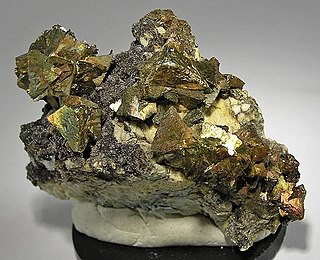
Chalcopyrite ( KAL-kə-PY-ryte, -koh-) is a copper iron sulfide mineral and the most abundant copper ore mineral. It has the chemical formula CuFeS2 and crystallizes in the tetragonal system. It has a brassy to golden yellow color and a hardness of 3.5 to 4 on the Mohs scale. Its streak is diagnostic as green tinged black.
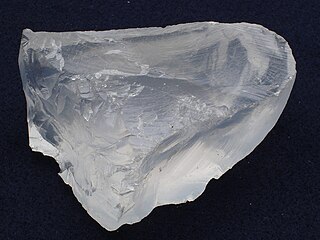
Petalite, also known as castorite, is a lithium aluminium phyllosilicate mineral LiAlSi4O10, crystallizing in the monoclinic system. Petalite occurs as colorless, pink, grey, yellow, yellow grey, to white tabular crystals and columnar masses. It occurs in lithium-bearing pegmatites with spodumene, lepidolite, and tourmaline. Petalite is an important ore of lithium, and is converted to spodumene and quartz by heating to ~500 °C and under 3 kbar of pressure in the presence of a dense hydrous alkali borosilicate fluid with a minor carbonate component. Petalite (and secondary spodumen formed from it) is lower in iron than primary spodumene, making it a more useful source of lithium in, e.g., the production of glass. The colorless varieties are often used as gemstones.

Anglesite is a lead sulfate mineral with the chemical formula PbSO4. It occurs as an oxidation product of primary lead sulfide ore, galena. Anglesite occurs as prismatic orthorhombic crystals and earthy masses, and is isomorphous with barite and celestine. It contains 74% of lead by mass and therefore has a high specific gravity of 6.3. Anglesite's color is white or gray with pale yellow streaks. It may be dark gray if impure.
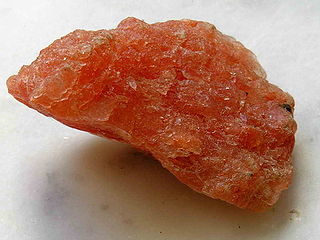
Sylvite, or sylvine, is potassium chloride (KCl) in natural mineral form. It forms crystals in the isometric system very similar to normal rock salt, halite (NaCl). The two are, in fact, isomorphous. Sylvite is colorless to white with shades of yellow and red due to inclusions. It has a Mohs hardness of 2.5 and a specific gravity of 1.99. It has a refractive index of 1.4903. Sylvite has a salty taste with a distinct bitterness.

Thenardite is an anhydrous sodium sulfate mineral, Na2SO4 which occurs in arid evaporite environments, specifically lakes and playas. It also occurs in dry caves and old mine workings as an efflorescence and as a crusty sublimate deposit around fumaroles. It occurs in volcanic caves on Mount Etna, Italy. It was first described in 1825 for an occurrence in the Espartinas Saltworks, Ciempozuelos, Madrid, Spain and was named for the French chemist, Louis Jacques Thénard (1777–1826).

Valentinite is an antimony oxide mineral with formula Sb2O3. Valentinite crystallizes in the orthorhombic system and typically forms as radiating clusters of euhedral crystals or as fibrous masses. It is colorless to white with occasional shades or tints of yellow and red. It has a Mohs hardness of 2.5 to 3 and a specific gravity of 5.76. Valentinite occurs as a weathering product of stibnite and other antimony minerals. It is dimorphous with the isometric antimony oxide senarmontite.

The Aures Mountains are an eastern prolongation of the Atlas Mountain System that lies to the east of the Saharan Atlas in northeastern Algeria and northwestern Tunisia, North Africa. The mountain range gives its name to the mountainous natural and historical region of the Aures.

Krennerite is an orthorhombic gold telluride mineral which can contain variable amounts of silver in the structure. The formula is AuTe2, but specimen with gold substituted by up to 24% with silver have been found ([Au0.77Ag0.24]Te2). Both of the chemically similar gold-silver tellurides, calaverite and sylvanite, are in the monoclinic crystal system, whereas krennerite is orthorhombic.
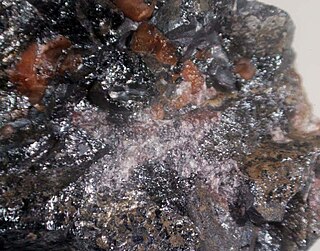
The rare mineral adelite, is a calcium, magnesium, arsenate with chemical formula CaMgAsO4OH. It forms a solid solution series with the vanadium-bearing mineral gottlobite. Various transition metals substitute for magnesium and lead replaces calcium leading to a variety of similar minerals in the adelite - duftite group.
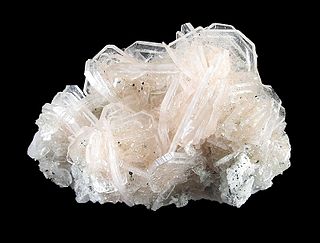
The name apophyllite refers to a specific group of phyllosilicates, a class of minerals. Originally, the group name referred to a specific mineral, but was redefined in 1978 to stand for a class of minerals of similar chemical makeup that comprise a solid solution series, and includes the members fluorapophyllite-(K), fluorapophyllite-(Na), hydroxyapophyllite-(K). The name apophyllite is derived from the Greek ἀποφυλλίζω apophylliso, meaning "it flakes off", a reference to this class's tendency to flake apart when heated, due to water loss. Exfoliation of apophyllite is also possible by treating it with acids or simply by rubbing it. These minerals are typically found as secondary minerals in vesicles in basalt or other volcanic rocks. A recent change (2008) in the nomenclature system used for this group was approved by the International Mineralogical Association, removing the prefixes from the species names and using suffixes to designate the species. A subsequent nomenclature change approved by the International Mineralogical Association in 2013 renamed the minerals to include both suffixes and prefixes, as shown above.
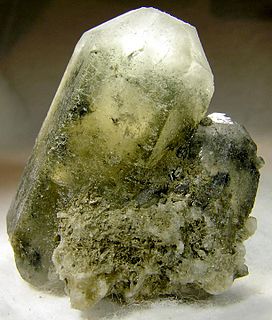
Hanksite is a sulfate mineral, distinguished as one of only a handful that contain both carbonate and sulfate ion groups. It has the chemical formula Na22K(SO4)9(CO3)2Cl.

Rutherfordine is a mineral containing almost pure uranyl carbonate (UO2CO3). It crystallizes in the orthorhombic system in translucent lathlike, elongated, commonly radiating in fibrous, and in pulverulent, earthy to very fine-grained dense masses. It has a specific gravity of 5.7 and exhibits two directions of cleavage. It appears as brownish, brownish yellow, white, light brown orange, or light yellow fluorescent encrustations. It is also known as diderichite.

Kermesite or antimony oxysulfide is also known as red antimony (Sb2S2O). The mineral's color ranges from cherry red to a dark red to a black. Kermesite is the result of partial oxidation between stibnite (Sb2S3) and other antimony oxides such as valentinite (Sb2O3) or stibiconite (Sb3O6(OH)). Under certain conditions with oxygenated fluids the transformation of all sulfur to oxygen would occur but kermesite occurs when that transformation is halted.
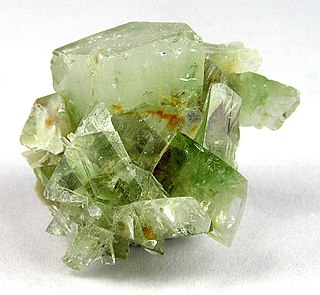
Augelite is an aluminium phosphate mineral with formula: Al2(PO4)(OH)3. The shade varies from colorless to white, yellow or rose. Its crystal system is monoclinic.

Roméite is a calcium antimonate mineral with the chemical formula (Ca,Fe,Mn,Na)2(Sb,Ti)2O6(O,OH,F). It is a honey-yellow mineral crystallizing in the hexoctahedral crystal system. It has a Mohs hardness of 5.5-6.0. It occurs in Algeria, Australia, Brazil, China, Europe, Japan, New Zealand, and the United States in metamorphic iron-manganese deposits and in hydrothermal antimony-bearing veins.

Taranakite is a hydrated alkali iron-aluminium phosphate mineral with chemical formula (K,Na)3(Al,Fe3+)5(PO4)2(HPO4)6·18 H2O. It forms from the reaction of clay minerals or aluminous rocks with solutions enriched in phosphate derived from bat or bird guano or, less commonly, from bones or other organic matter. Taranakite is most commonly found in humid, bat inhabited caves near the boundary of guano layers with the cave surface. It is also found in perennially wet coastal locations that have been occupied by bird colonies. The type location, and its namesake, the Sugar Loaf Islands off Taranaki, New Zealand, is an example of a coastal occurrence.

Ardaite is a very rare sulfosalt mineral with chemical formula Pb19Sb13S35Cl7 in the monoclinic crystal system, named after the Arda River, which passes through the type locality. It was discovered in 1978 and approved by the International Mineralogical Association in 1980. It was the second well-defined natural chlorosulfosalt, after dadsonite.
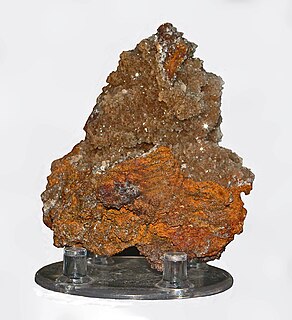
Tarbuttite is a rare phosphate mineral with formula Zn2(PO4)(OH). It was discovered in 1907 in what is now Zambia and named for Percy Tarbutt.

Benstonite is a mineral with formula Ba6Ca6Mg(CO3)13. Discovered in 1954, the mineral was described in 1961 and named after Orlando J. Benston (1901–1966).

Felsőbányaite or basaluminite is a hydrated aluminium sulfate mineral with formula: Al4(SO4)(OH)10·4H2O. It is a rare white to pale yellow mineral which typically occurs as globular masses and incrustations or as minute rhombic crystals. It crystallizes in the monoclinic crystal system.




















